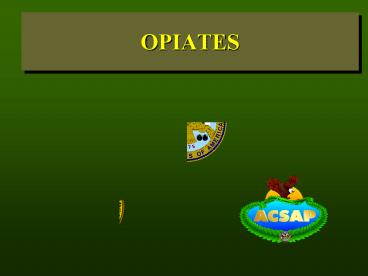OPIATES - PowerPoint PPT Presentation
1 / 17
Title:
OPIATES
Description:
OPIATES CONTENT. What are Opiates? History. How are Opiates Consumed? What are the Effects? Physical Damage. Physiological Damage. Use in the United States – PowerPoint PPT presentation
Number of Views:169
Avg rating:3.0/5.0
Title: OPIATES
1
OPIATES
2
- OPIATES CONTENT
- What are Opiates?
- History
- How are Opiates Consumed?
- What are the Effects?
- Physical Damage
- Physiological Damage
- Use in the United States
- Testing for Opiates
- Useful Links
3
- WHAT ARE OPIATES?
- Opiates are drugs that are derived from the
Poppy Plant and are Central Nervous System (CNS)
depressants. - The most common opiates are
- Opium
- Heroin
- Morphine
- Codeine
- There are several synthetic opiates available,
such as methadone, that were created as pain
killers and to help treat heroin addiction.
4
HISTORY of OPIATES
- 1903 Heroin addiction in the United States rises
at an alarming rate. - 1905 U.S. Congress bans opium.
- 1906 U.S. Congress passes the Pure Food and Drug
Act which caused that availability and
consumption of opiates to decline dramatically. - 1909 The first federal drug prohibition passes in
the U.S., outlawing the importation of opium and
opiates. - 1910 The Chinese convince Britain to dismantle
the India-China opium trade.
5
HISTORY of OPIATES
- 1914 The Harrison Narcotics Act is passed which
required all doctors and pharmacists that
prescribed opiates to register with the
government and pay a tax. - 1922 The Narcotic Import and Export Act is
passed which restricted the importation of crude
opium except for medicinal purposes. - 1923 The first federal drug agency, U.S. Treasury
Departments Narcotic Division, is formed and all
narcotic sales are banned. - 1924 The Heroin Act is passed and the
manufacture, possession, and consumption of
heroin is made illegal. - 1925 In the wake of the federal ban on opiates, a
thriving black market opens in New Yorks
Chinatown.
6
HISTORY of OPIATES
- 1930s The majority of illegal opiates smuggled
into the U.S. comes from China. - 1945 Burma gains independence from Britain
following WWII and opium cultivation flourishes
in the surrounding areas. - 1962 Burma outlaws the cultivation, possession
and consumption of opiates. - 1965-70 Opium and heroin smuggling into the U.S.
is at an all time high. This is blamed in part
on the U.S. involvement in the Vietnam War. An
estimated 750,000 heroin addicts live in the
United States.
7
HISTORY of OPIATES
- 1970 Controlled Substance Act is passed which
divided drugs into categories and set penalties
for crimes involving narcotics. - Mid 1970s Heroin and Opiate use in the U.S.
begins to subside. Mexican heroin enters the
market and would remain a large player for almost
a decade. - 1978 The U.S. and Mexican governments meet and
decide on a way to eliminate the Opium farms in
Mexico. The U.S. proceeded to spray the Poppy
fields with Agent Orange.
8
HISTORY of OPIATES
- 1988 Opiate production in Burma increases due to
the State Law and Order Restoration Council, the
Burmese junta regime. The single largest heroin
seizure is made in China, 2,400 pounds. - 1992 Colombias drug lords introduce a high grade
form of heroin in the U.S. - 1993 The Thai Army with support from the U.S. DEA
destroyed thousands of acres of opium poppies. - 1995 The Golden Triangle area of Southeast Asia
is the worlds leading producer of opiates, over
2,500 tons annually.
9
HISTORY of OPIATES
- 1999 United Nations Drug Control Policy (UNDCP)
estimates that 75 of the worlds opiates come
from Afghanistan and that a bumper crop of over
4,600 tons exists there. - 2000 Taliban leader Mullah Omar bans opiate
cultivation in Afghanistan, the UNDCP confirms
the ban. - Fall 2001 War in Afghanistan, opiates, primarily
heroin, flood the Pakistani and world market.
10
STREET NAMES
- Smack
- Morf
- Mud
- M
- Horse
- Muzzle
- Junk
- Dollies
- H
- Hairy
- Black Tar
- Hazel
- Soapium
- Poppy
- Chiva
- China White
- Tecata
- Flower
11
HOW ARE OPIATES CONSUMED?
Snorted Because of the high potency of heroin
today, more and more users are snorting the drug.
Injected Injecting opiates, specifically
heroin, is still the choice ingestion method.
Many addicts choose to inject the drug because of
the quick and powerful onset of the effects.
Users can inject the drug directly into the blood
stream or the muscle tissue.
Smoked The method of choice for opium is
smoking the tar like substance. Other opiates
are often smoked on top of marijuana. This is
known as snow capping.
Eaten All opiates can be consumed orally. Many
prescription pain killers on the market today are
opiates.
12
SHORT TERM EFFECTS
- Nausea/Vomiting
- Loss of Appetite
- Absence of Stress
- Itchy Skin
- Altered Mental Process
- Loss of Concentration
- Absence of Pain
- Loss of Sex Drive
- Impaired Vision
- Constipation
- Sleepiness
- Overdose/Death
13
LONG TERM EFFECTS
- Severe Constipation
- Pregnancy Complications
- Contracted Pupils
- Immune System Damage
- Liver Damage
- Loss of Sex Drive
- Kidney Damage
- Severe Weight Loss
- Lung Damage
- Frequent Infections
- Brain Damage
- Collapsed Veins
- Menstrual Irregularities
- Death
14
OPIATE USE IN THE U.S. ARMY
Percentage of Soldiers in the United States Army
That Have Used Opiates in the Past Month and Past
Year. () 1995 1998
DoD Health Survey (1995 1998)
15
OPIATE TESTING IN THE ARMY
- Opiates can be detected in urine up to 2-3 days
after it is ingested. - Opiates are tested on a rotational schedule
within the Army.
16
ADDITIONAL RESOURCES
- http//www.erowid.org/chemicals/opiates/opiates.sh
tml - http//www.nida.nih.gov/Infofax/heroin.html
- http//www.health.org
- http//www.sayno.com/opiates.html
- http//www.whitehousedrugpolicy.gov/drugfact/heroi
n/index.html
17
Additional Information
- Additional information on Opiates can be found
by contacting your local Army Substance Abuse
Program or by visiting acsap.army.mil

